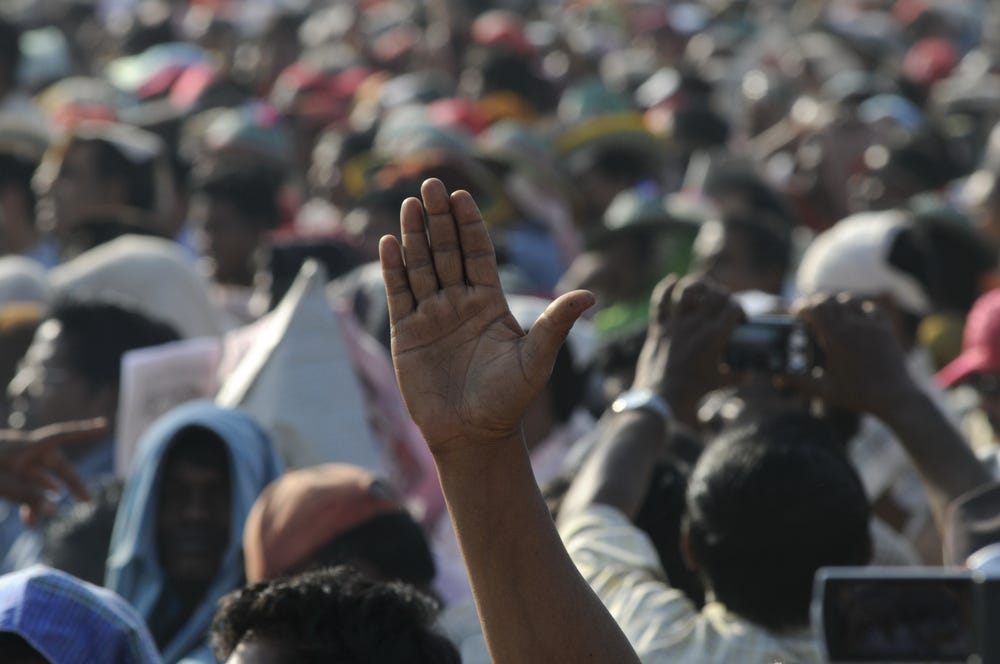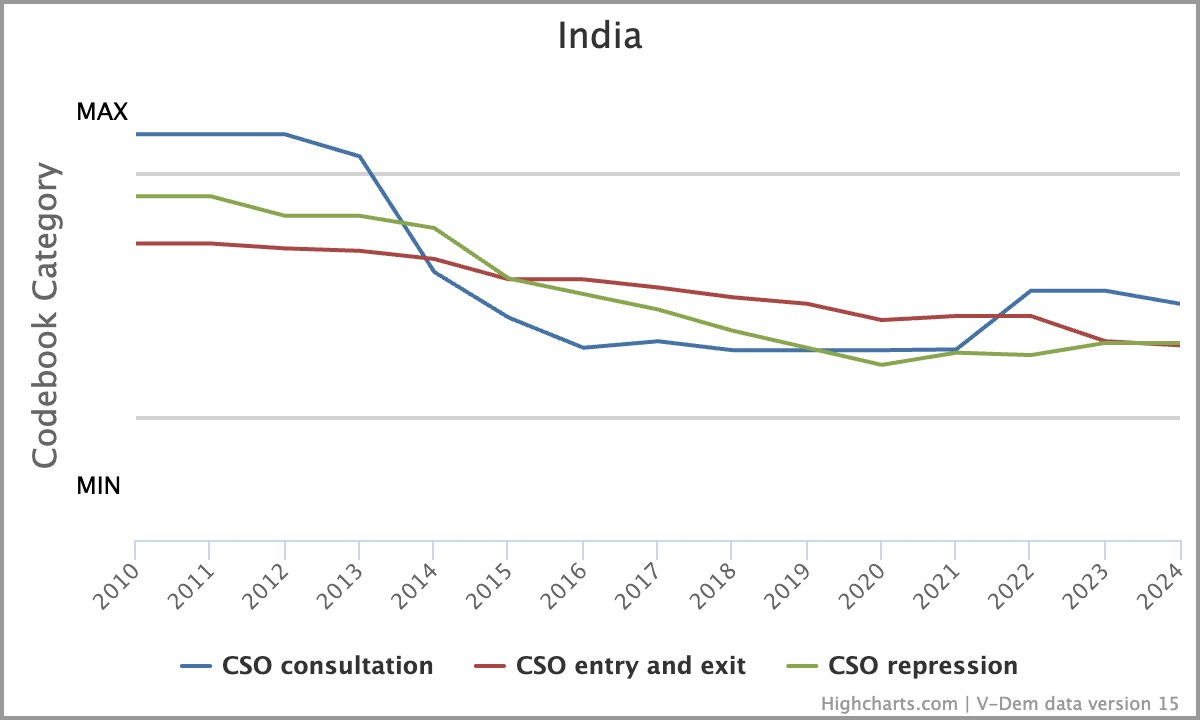By Laura Adams
Senior officials in the Trump administration recently accused—without evidence or reasoning—prominent US foundations of inciting violence and being part of a domestic terrorism network. They signaled forthcoming investigations or possible loss of tax-exempt status for these and other “radical left institutions.” In response, more than 150 foundations and nonprofits signed a statement condemning attempts to mischaracterize their work or restrict their freedom of speech and freedom to give.
I’ve spent years studying civil society organizations and social movements in authoritarian countries, and I’ve seen this playbook before. In case after case, targeting foundations, and the nonprofit organizations they fund, isn't just about eliminating support for causes such as immigrant rights. It's about eliminating a threat to the regime’s power by restricting "civic space”—the legal, practical, normative and institutional structures that enable citizens to associate, speak, assemble, fundraise, and participate in public life. When authoritarians consolidate power, they don't just go after vulnerable groups; they eventually target the entire civic sector, damaging the environment that enables nonprofits to work and even exist.
The nonprofits and foundations that banded together to sign the statement have the right idea, as does Diane Yentel of the National Council of Nonprofits when she says “our silence will not protect us.” The philanthropic sector must not assume that in a few years it will be business as usual again. Understanding how patterns of repression against foundations and nonprofits have played out in other countries, and how the civic sector has fought for its right to exist in other contexts, can help organizational leaders and social movements think strategically about protecting the operating environment for civil society.
How authoritarians shrink civic space
Authoritarians and their supporters close civic space through legal, administrative, economic, informational, and coercive actions. Changes in registration and “foreign agent” rules, blocks on bank accounts, threats to tax status, labeling opponents as “terrorists” or “corrupt,” targeted policing, and strategic litigation against public participation (SLAPP suits) are the most common tactics. As seen in places like Nicaragua, Russia, and Turkey, the aim is to raise the costs of operating until nongovernmental organizations (NGOs) shut down, self-censor, capitulate or serve the state’s policy goals rather than their constituents.
An important example for the US comes from the world’s largest multiethnic democracy. In India under Prime Minister Narendra Modi, civic space has steadily shrunk since 2014. The government began labeling prominent nonprofits as foreign-influenced or “anti-national,” tightened banking and reporting rules, and used a counter-terrorism law as a tool to detain student activists and human rights defenders without charges for extended periods. Thousands of NGOs lost permission to receive foreign funds or had their offices raided, and a few high-profile arrests of nonprofit leaders deterred many others from criticizing the government. These measures collectively closed civic space by degrading the operating environment for nonprofits, not by banning them outright, but by making it impossible for many to function.
Data from the Varieties of Democracy project shows the impact of the crackdown. In the graph above, the red “CSO entry and exit” line shows how legal changes increased government control over whether nonprofits were allowed to form or continue to exist. Similarly, the green “CSO repression line” reflects the government’s attempts to threaten and harass nonprofits. These downward trends were preceded by a striking decline in advocacy efficacy, shown in the blue “CSO consultation line,” which means that nonprofit organizations’ ability to access and influence policymakers was a leading indicator for what was to come.
Since 2014, more than 20,000 Indian nonprofits have closed. It’s hard to imagine what would happen if 20,000 nonprofits in the United States were forced to close due to harassment, disinformation, funding restrictions, or onerous registration requirements. Let’s talk about how to make sure that doesn’t happen.
Strategies to defend civic space
Around the world, when civic space is restricted, diverse civic actors have come together to push back, sometimes succeeding in preserving—or even expanding—civic space. Here are key lessons learned and recommendations for the civic sector in the US on how to defend the enabling environment that allows them to exist.
Legal advocacy and strategic litigation has been fairly successful in India. Strategies include lobbying against bills that harm the enabling environment for nonprofits, monitoring and publicizing new laws and regulations, challenging unconstitutional restrictions in court, and using legal defense funds to slow or reverse illiberal measures. Many US foundations and nonprofits are already pushing back through litigation concerning Executive Orders and policy implementation, but with some exceptions, it’s not clear that they are mobilizing to prevent existential threats to the enabling environment of nonprofit work itself. Organizations with resources and influence need to increase their support for field-wide legal defense, monitoring legislation at the state level, and policy advocacy for freedom of expression and association that will protect neutral, predictable rules for nonprofit operations.
Broad coalition building was key to blocking executive attacks on civic space in Ecuador, Slovakia, and elsewhere. This means forming alliances across sectors (including faith groups, unions, professional bodies, and community organizations) and across partisan divides to defend democratic procedures and institutions, rather than partisan agendas. In the US, the politicization of the Internal Revenue Service and the persecution of organizations based on speech are alarming to nonprofits of every political persuasion. New pro-democracy coalitions and networks have come together in the last year and are gaining traction. However, many are focused on how the administration is targeting particular groups and issues, instead of focusing on defending fundamental freedoms and the enabling environment for civil society. The latter might be a way to bring people together who otherwise disagree on the administration’s policies.
Multi-level engagement requires working simultaneously at federal, state, and local levels, pivoting advocacy to places where governments are more responsive. While the national news is unrelenting, democracy advocates can’t lose sight of the importance of state and local politics. Civic space has been closing in many states, but there are challenges in tracking, interpreting, and responding to these changes. There is a need for frequently updated, state-level measures of associational rights, how protests are policed, administrative burdens on nonprofits, and so on. Advances in AI-assisted, human in the loop data collection methods means this can be done at a scale and speed that wasn’t possible before. Donor support for efforts to collect, systematize, and analyze such data will help national organizations more strategically target threats and opportunities at multiple levels of government.
Operational adaptation is a strategy used in many authoritarian contexts and involves developing contingency plans for different scenarios, investing in digital security, risk mitigation practices, and psychosocial support, and continuity planning to withstand repression. US nonprofits are just starting to move beyond the deer-in-headlights stage of this long struggle and need to do scenario planning and commit to act collectively when they are threatened. To avoid complying in advance, organizations can pre-identify red lines and institutional responses. At a recent workshop I ran, we discussed a scenario where multiple states passed "Pecuniary Duty and Market Neutrality" laws that bar companies doing business with the state from considering environmental, social, and governance (ESG) factors in their work. We talked about how to prevent such laws from passing, thereby mitigating a threat to nonprofit funding that comes from ESG programs. It is equally important to plan how to adapt when such laws do pass.
America is a civic nation with a rich, diverse civil society that includes countless foundations funding every cause, myriad religious and civic institutions, robust professional associations, and millions of people serving their communities. This civic infrastructure is our strength; defending it requires savvy strategy and broad-based collective action.
Laura Adams is a sociologist who has studied civil society and social movements in authoritarian states for the last 20 years. She is a Founding Partner and Principal, Strategy and Learning at Eidos Insights Research Partners.




You’re absolutely right Laura. Unfortunately I think it’s going to continue to get worse before the civic organizations in America are really motivated to fight back